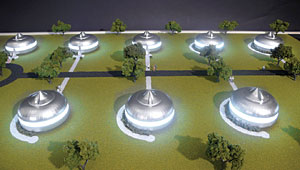One of the few to appreciate his work consistently was Banham who, in The Architecture of the Well-Tempered Environment got it just right, citing: “Paul Valery’s contrast between Eupalinos, the architect, and Tridon, the shipwright. The former was preoccupied with the right method of doing the allotted tasks, and deploying the accepted methods of his calling, and seemed to find a philosophical problem in every practical decision. Tridon, on the other hand, applied every technology that came conveniently to hand, whether or not it was part of the shipbuilding tradition, and treated the sayings of philosophers as further instruction on the direct solution of practical problems.” Bucky — who early imbibed a nautical tradition and whose late project for a floating Habitat was called “Triton City” — fits this description to a T. This made it tough for the profession to internalize him as one of its own.

The cool reception surely also stemmed from the fact that Bucky authentically delivered on Modernism’s promises, that he pulled its chestnuts from the fire, revealing its product to be far less than it claimed. In Theory and Design in the First Machine Age (1960), Banham deploys two telling visual comparisons, the first between Corbusier’s villa at Garches (1928–30) and Bucky’s Dymaxion House (1927–30). Corb’s familiar work embodies its Modernity via entirely representational means — through its starkly planar composition, its free plan, its slim pilotis hoisting it above the ground plane. Fuller’s house, on the other hand, is authentically radical in its suspended construction, its use of light, nontraditional materials, and its organization around a premanufactured mechanical core — form following function to the point of defamiliarization. On the very next page, Banham contrasts a design by Gropius for the body of the 1930 Adler Cabriolet with Bucky’s Dymaxion car of 1933. The Adler looks thoroughly antique with a few minor modifications around the margins; Bucky’s car looks, and acts, like the future.
Fortunately, Fuller’s influence exceeded the architectural profession’s boundaries. His domes were received not simply for their celestial iconography (the first picture of the “whole earth” was not taken until the ’60s), but for their astonishing practicality and their suggestively communal style of enclosure. Bucky pursued the construction of various “geoscopes,” meant, like his undistorted Dymaxion Maps, to model the world and display quantitative information about it. (He had hoped his Expo dome would do this, but the technology wasn’t yet there.) He was, in project and proclamation, constantly hectoring us Earthlings to pilot our spaceship by gathering all possible navigational data to control — to take responsibility for — our collective destiny.
The insistence that thought, that the universe, was recursively patterned was at the core of Bucky’s investigation and beliefs, his metaphysic. The main artifact of this quest was geometry and the centrality of his four-vectored organization has received posthumous vindication in the discovery of “fullerences,” carbon allotropes structured like geodesics that are keys to the world of nanotechnology. Here, too, is a lesson for architecture today, which largely continues to be at a loss for its mission. Modernism foundered theoretically in its unstable oscillations between formal invention and the creation of new styles of human subjectivity. One was not really radical, while the other was intrinsically beyond its ken (if not its hubris). Bucky asked a more interesting question: “What can I do for my fellow man that doesn’t take away his freedom.” Instead of falling into the sterility of Modernist politics, Bucky looked beyond architecture to the macro-scale of the global systems and flows that produced the criteria for building and to the micro-scale of the geometric organization of space that provides the efficient substance of construction. A Platonist in his gut, he knew that ideas produced the meaning of form.
I find Bucky more and more inspirational, especially for the freedom of his research. Two projects done with Shoji Sadao in 1960 make the point. The first of these is the much-ridiculed dome over Midtown Manhattan, criticized either as “impractical” (how to buff the glass, how to get the traffic through) or as simply a megalomaniacal expression of an environment overly controlled. Such criticisms miss the project’s simple point: The membrane has a surface area approximately 1/64 that of the aggregated exteriors of all the buildings within it, and Bucky argued that the larger the dome, the greater the energy conserved. The Manhattan dome is simply rhetorical, a device to describe the environmental inefficiencies of standard practice.
Likewise, the Cloud Nine project for a series of sphere cities floating in the atmosphere is both an acid dream and the embodiment of a simple set of physical calculations, suggesting that if we could build such giant geodesic balloons, they would hang stably, fresh moons lightly pinioned by elemental forces. Bucky surely knew that the magic in the universe was there for the figuring out.



Post a comment to this article
Report Abusive Comment